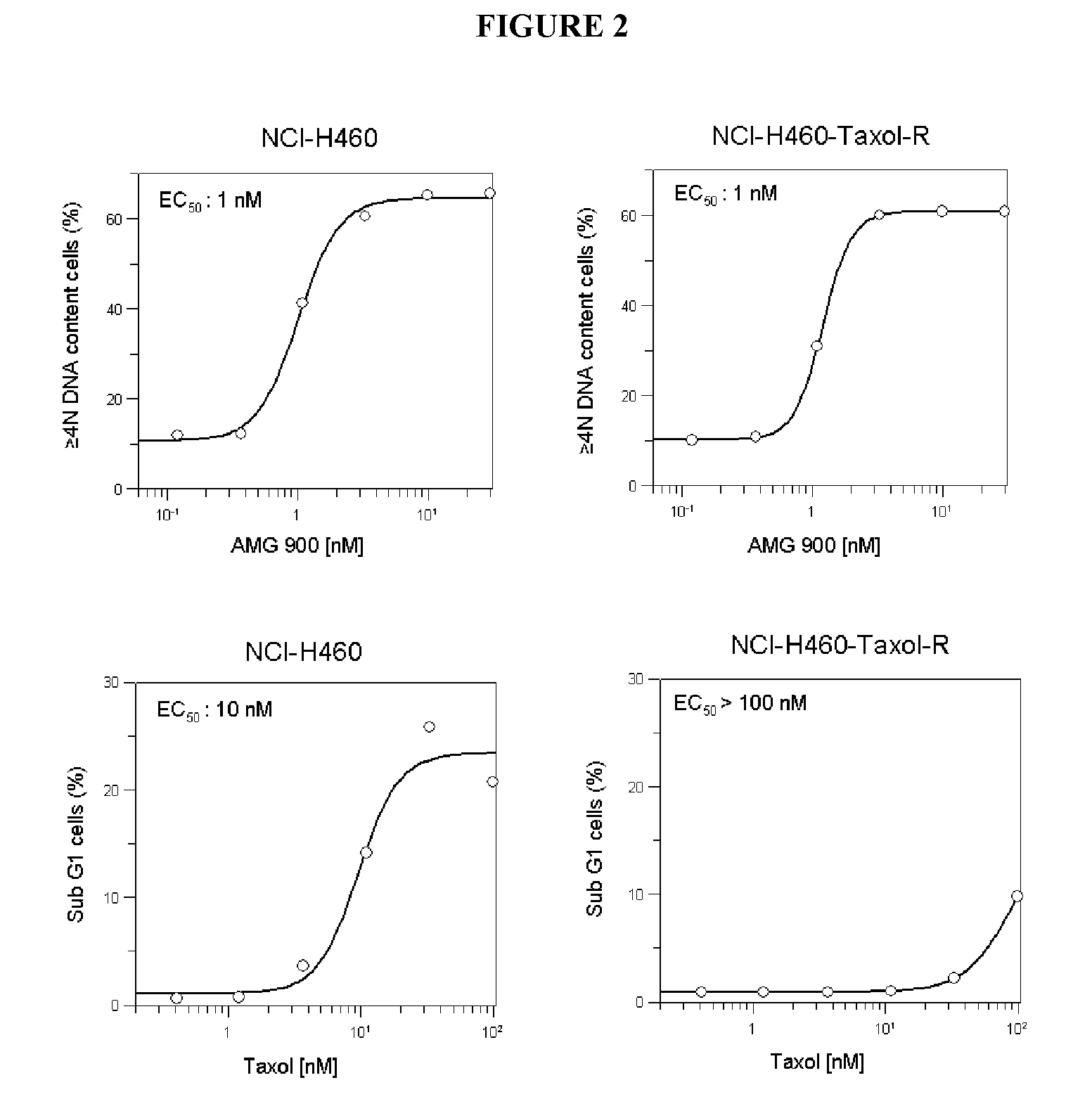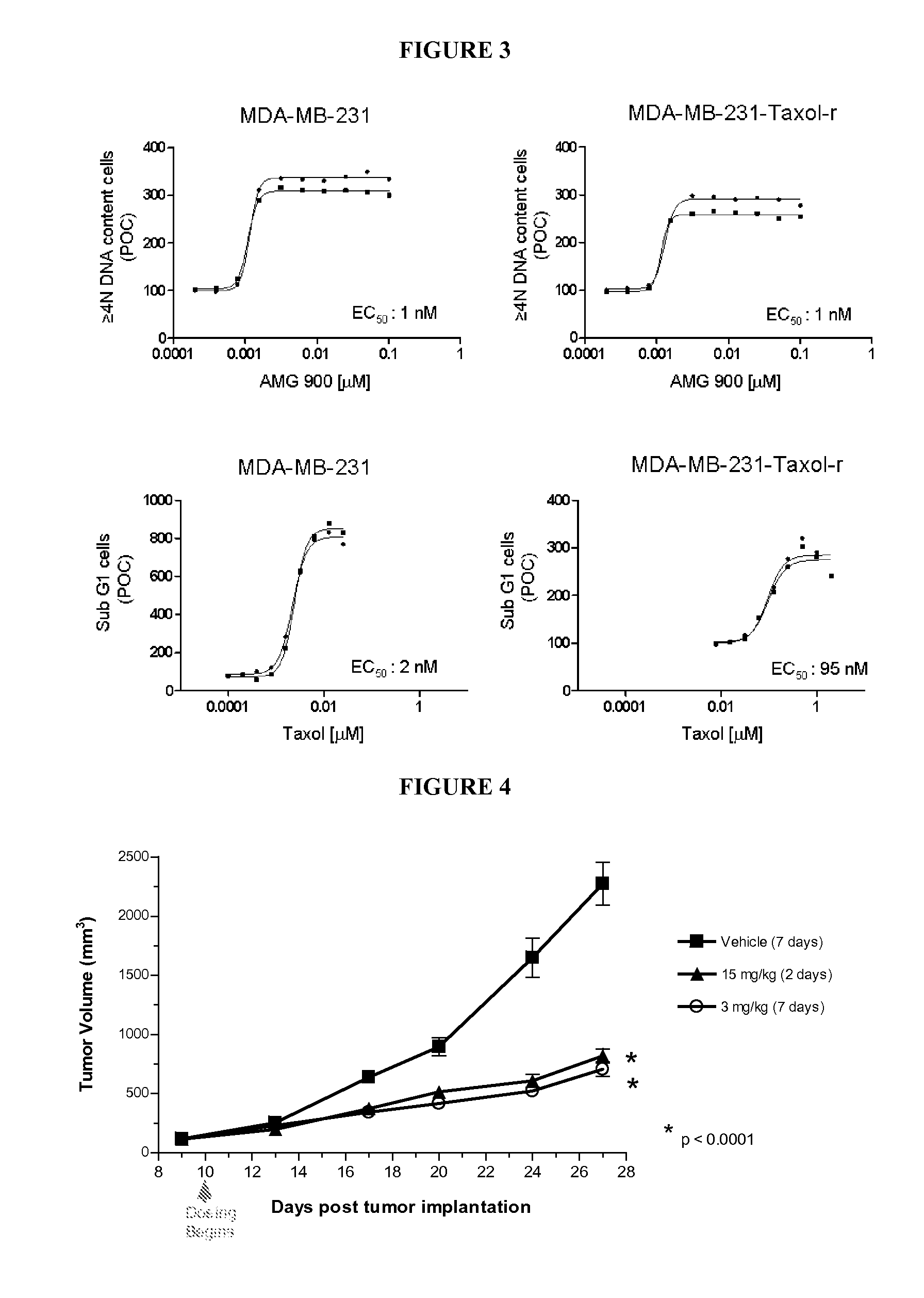Use Of N-(4-((3-(2-Amino-4-Pyrimidinyl)-2-Pyridinyl)Oxy)Phenyl)-4-(4-Methyl-2-Thienyl)-1-Phthalazinamine In The Treatment Of Antimitotic Agent Resistant Cancer
a technology of antimitotic agent and phthalazinamine, which is applied in the direction of heterocyclic compound active ingredients, drug compositions, biocides, etc., can solve the problems of mis-segregation of chromosomes, uncontrollable and unregulated proliferation of cells that have been transformed into cancerous cells, and inability to detect or repair mitotic errors
- Summary
- Abstract
- Description
- Claims
- Application Information
AI Technical Summary
Benefits of technology
Problems solved by technology
Method used
Image
Examples
example 1
[0036]
Synthesis of N-(4-((3-(2-amino-4-pyrimidinyl)-2-pyridinyl)oxy)phenyl)-4-(4-methyl -2-thienyl)-1-phthalazinamine (AMG 900)
[0037]Step 1: 4-(2-chloropyridin-3-yl)pyrimidin-2-amine
In an argon purged 500 mL round bottom flask placed in an isopropanol bath, was added sodium metal (3.40 g, 148 mmol) slowly to methanol (180 mL). The mixture was stirred at room temperature (RT) for about 30 minutes. To this was added guanidine hydrochloride (12.0 mL, 182 mmol) and the mixture was stirred at RT for 30 minutes, followed by addition of (E)-1-(2-chloropyridin-3-yl)-3-(dimethylamino)prop-2-en-1-one (12.0 g, 57.0 mmol), attached air condenser, moved reaction to an oil bath, where it was heated to about 50 ° C. for 24 h. Approximately half of the methanol was evaporated under reduced pressure and the solids were filtered under vacuum, then washed with saturated sodium bicarbonate (NaHCO3) and H2O, air dried to yield 4-(2-chloropyridin-3-yl)pyrimidin-2-amine as off white solid. MS m / z=207[M+1...
example 2
[0042]To investigate whether AMG 900-induced suppression of aurora kinase A and B activity inhibits cell proliferation, the antiproliferative effect of AMG 900 was evaluated in vitro using 32 human tumor cell lines. As shown in Table 1 and Table 2, AMG 900 exhibited antiproliferative activity across both solid and hematologic tumor cell lines. This antiproliferative activity was seen with concentrations of AMG 900 in the low nanomolar range (EC50 values 1 to 5 nM). Importantly, four of these AMG 900-sensitive solid tumor cell lines (HCT15, MES-SA Dx5, 769P, and SNU449) are resistant to paclitaxel and other chemotherapeutic agents. Cancer cells resistant to multiple drugs of different chemical structures and / or resistant to drugs directed at different targets are termed “multidrug resistant”. One prominent mechanism of multidrug resistance (MDR) utilized by cancer cells is drug efflux mediated by a family of ATP-binding cassette (ABC) transporters, such as the mdr-1 gene product, P-g...
example 3
[0060]To investigate whether AMG 900-induced suppression of aurora kinase activity inhibits cell proliferation, the antiproliferative efficacy of AMG 900 was evaluated in-vivo in multiple human cancer xenograft models, including breast, colon, leukemia, lung, pancreatic, and uterine cancer models, grown in athymic nude mice. Mice were administered AMG 900 orally at 3.75, 7.5, or 15 mg / kg BID for 2 consecutive days per week or 3 mg / kg BID everyday for the duration of the study beginning when tumors were established. The reagents, solutions, equipment, formulation of AMG 900, tumor volume measurements and calculations were generally as described in Example 4 below. AMG 900 was found to significantly inhibited tumor growth in all xenograft models tested compared with the vehicle control group (Table 4).
TABLE 4AMG 900 Inhibits the Growth of Multiple Xenograft ModelsPaclitaxelsensitiveTumorCellAMG 900in vitroOriginLine% TGI*yesColonHCT 11683noColonHCT1551yesColonColo 20558yesLungNCI-H460...
PUM
| Property | Measurement | Unit |
|---|---|---|
| flow rate | aaaaa | aaaaa |
| time | aaaaa | aaaaa |
| concentration | aaaaa | aaaaa |
Abstract
Description
Claims
Application Information
 Login to View More
Login to View More - R&D
- Intellectual Property
- Life Sciences
- Materials
- Tech Scout
- Unparalleled Data Quality
- Higher Quality Content
- 60% Fewer Hallucinations
Browse by: Latest US Patents, China's latest patents, Technical Efficacy Thesaurus, Application Domain, Technology Topic, Popular Technical Reports.
© 2025 PatSnap. All rights reserved.Legal|Privacy policy|Modern Slavery Act Transparency Statement|Sitemap|About US| Contact US: help@patsnap.com



